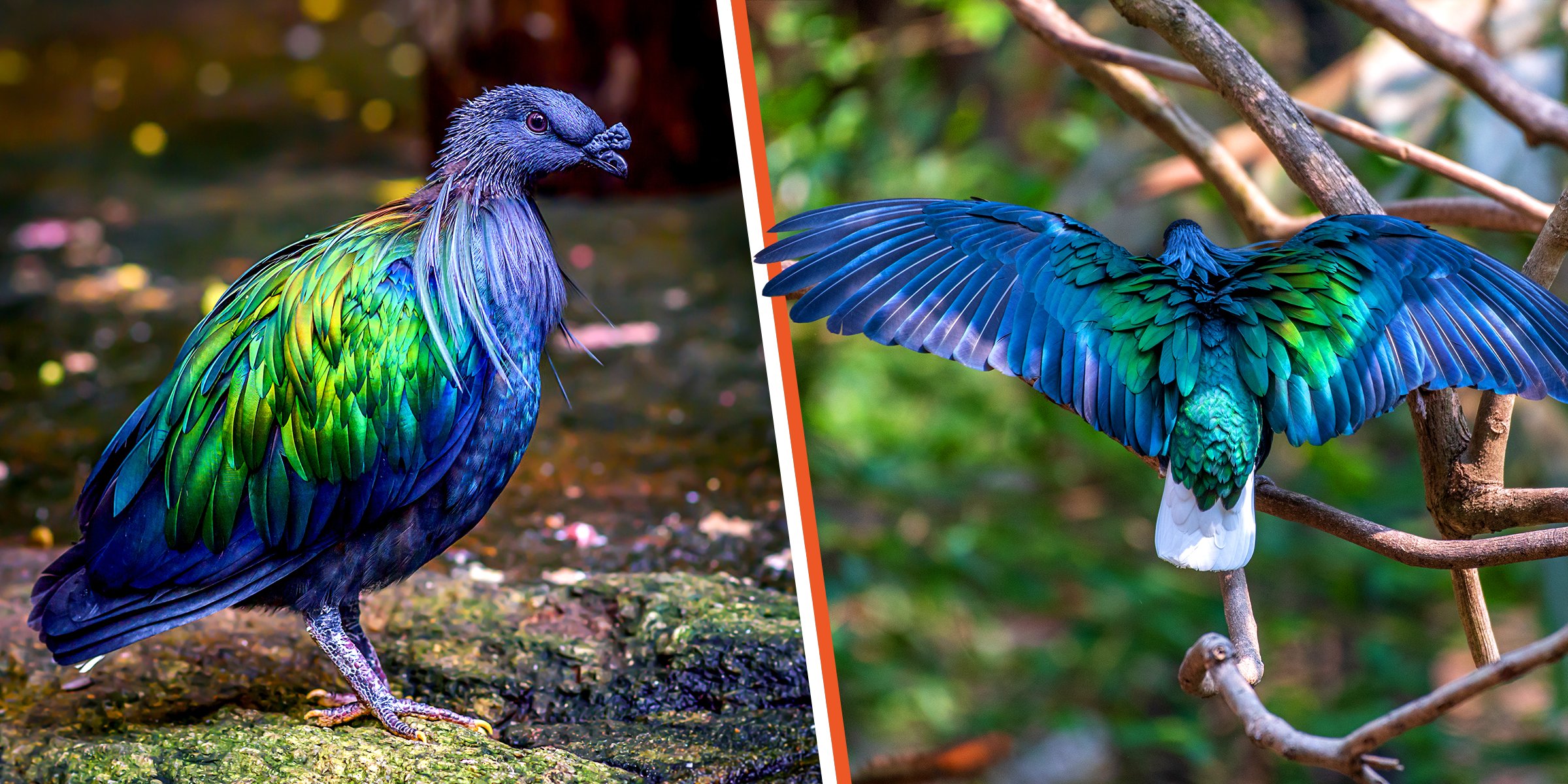
Amazing Nicobar Pigeon Dazzles with Its Charming Rainbow Colors Showcasing How Beautiful Nature Is
Birds are one of the most magnificent creatures on earth, offering an exciting and closer look at nature's raw and unfiltered beauty. Their sparkling colors, charming antics, and musical voices have magic and a lovely aura. Nicobar pigeons are no strangers to these phenomena.
Nature is a canvas where God paints the most exquisite images, and each one of them can deservingly be dubbed a masterpiece. Birds, irrespective of their varying species, have been blessed with the ability to draw our attention and hold us in a trance due to their everlasting charm.
Birds manifest nature's divine glory with enriching color patterns, a vast display of plumage, and an array of eye-catching characteristics. Today's feature story is a love letter to the alluring Nicobar pigeon, including facts about this beautiful bird and its ties to the famous Dodo bird.
Natural Habitats, Body Structure & Lifespan
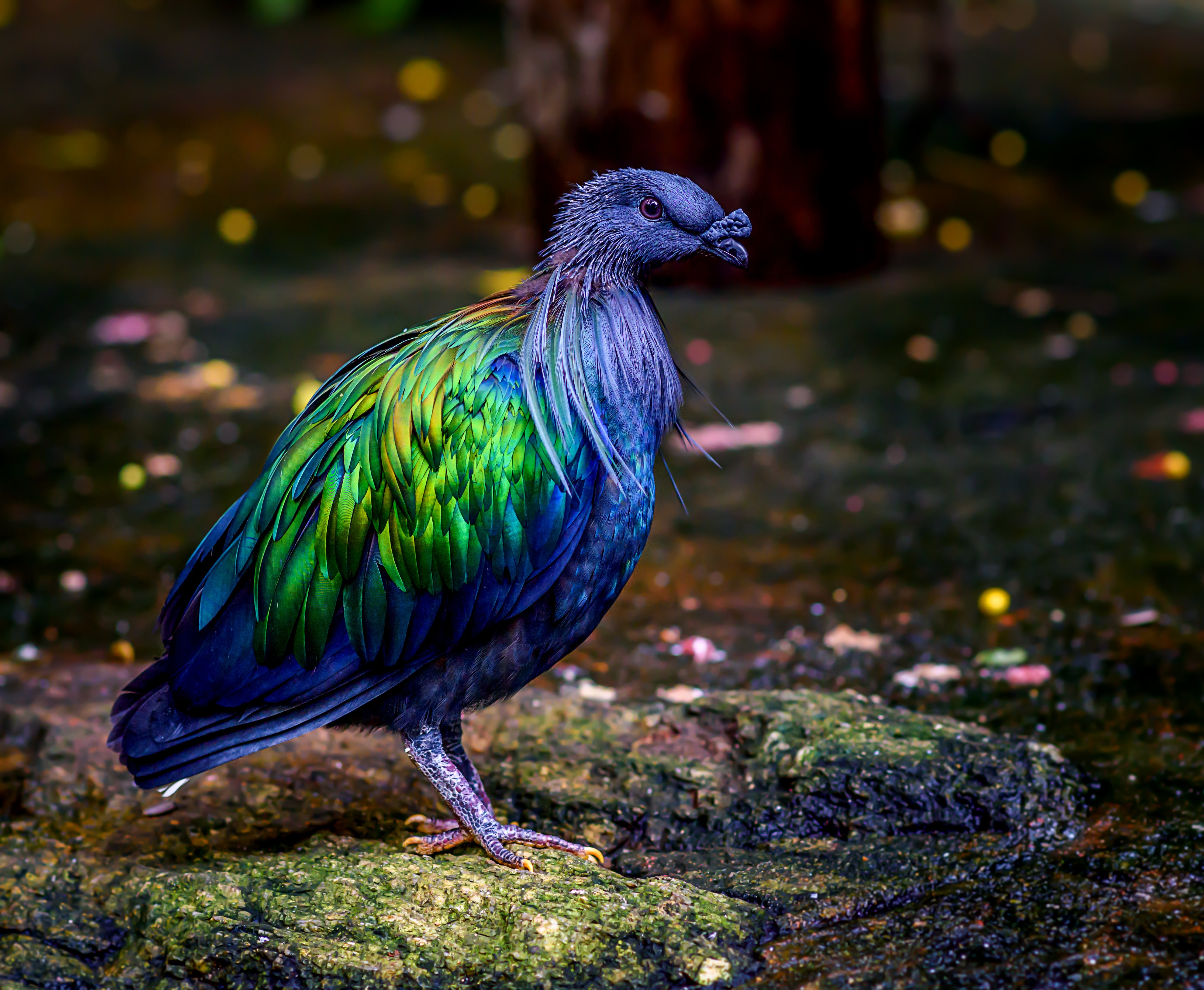
A Nicobar pigeon | Source: Shutterstock
The Nicobar pigeon, also known by its scientific name, "Caleonas nicobarica," is native to Southeast Asia and found in lowland forests, mangroves, and islands on the Indian and Western Pacific Oceans.
Sadly, the Nicobar is also on the brink of extinction, like its famous relative, and is threatened by the same factors that once contributed to the Dodo's disappearance from the earth.
Its natural habitats include the Nicobar Islands, extending from eastward India to New Guinea, Malaysia, the Philippines, and Indonesia. This bird comprises a mane of lovely feathers and shimmering colors in copper and metallic bluish-green reflections.
The male bird stands out because of a tiny black knob at the base of its bill. Its body is almost 16 inches long and weighs between one and two pounds. On average, its lifespan varies between eight to 12 years in the wilderness and about 10 to 15 years in human care.
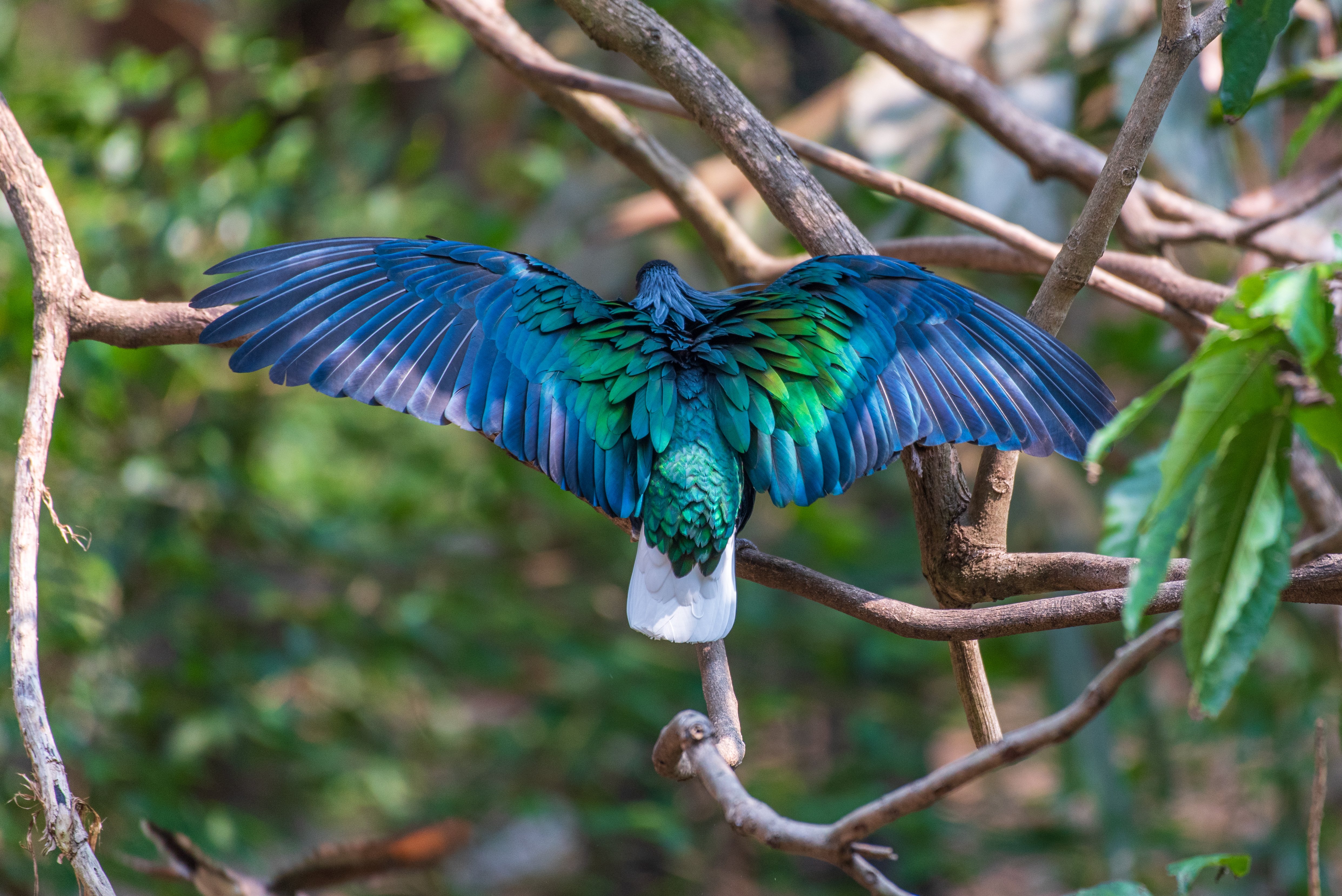
A Nicobar pigeon pictured spreading its wings | Source: Shutterstock
Feeding & Behavioral Patterns & Conservation Status
The Nicobar pigeon is also referred to as the "vulturine pigeon," "white-tailed pigeon," and the "hackled pigeon." This spectacular pigeon has been blessed with a highly muscular gizzard, which functions as its second stomach and facilitates the grinding of food, such as hard nuts.
This ground-dwelling bird relies on eating corn, fruits, invertebrates, and primarily hard seeds in the wild regions. On the other hand, ones kept in the zoo can develop an affinity for insects, pigeons and paradise pellets, grains, and berries. They mainly feed on the ground in clusters.
Nicobars birds are genuinely one-of-a-kind, but they're at a growing risk of being almost threatened due to many reasons, including hunting, habitat loss, the pet trade, deforestation of wooded regions on the islands, and the introduction of cats and rats to their breeding grounds that jeopardize their survival.
In the wake of the factors mentioned above, the lovely bird species faces a serious threat to its existence. It's been listed as "near threatened" by the IUCN, also known as the International Union for Conservation of Nature.
Vibrant Plumes, Rainbow Colors & Nesting Grounds
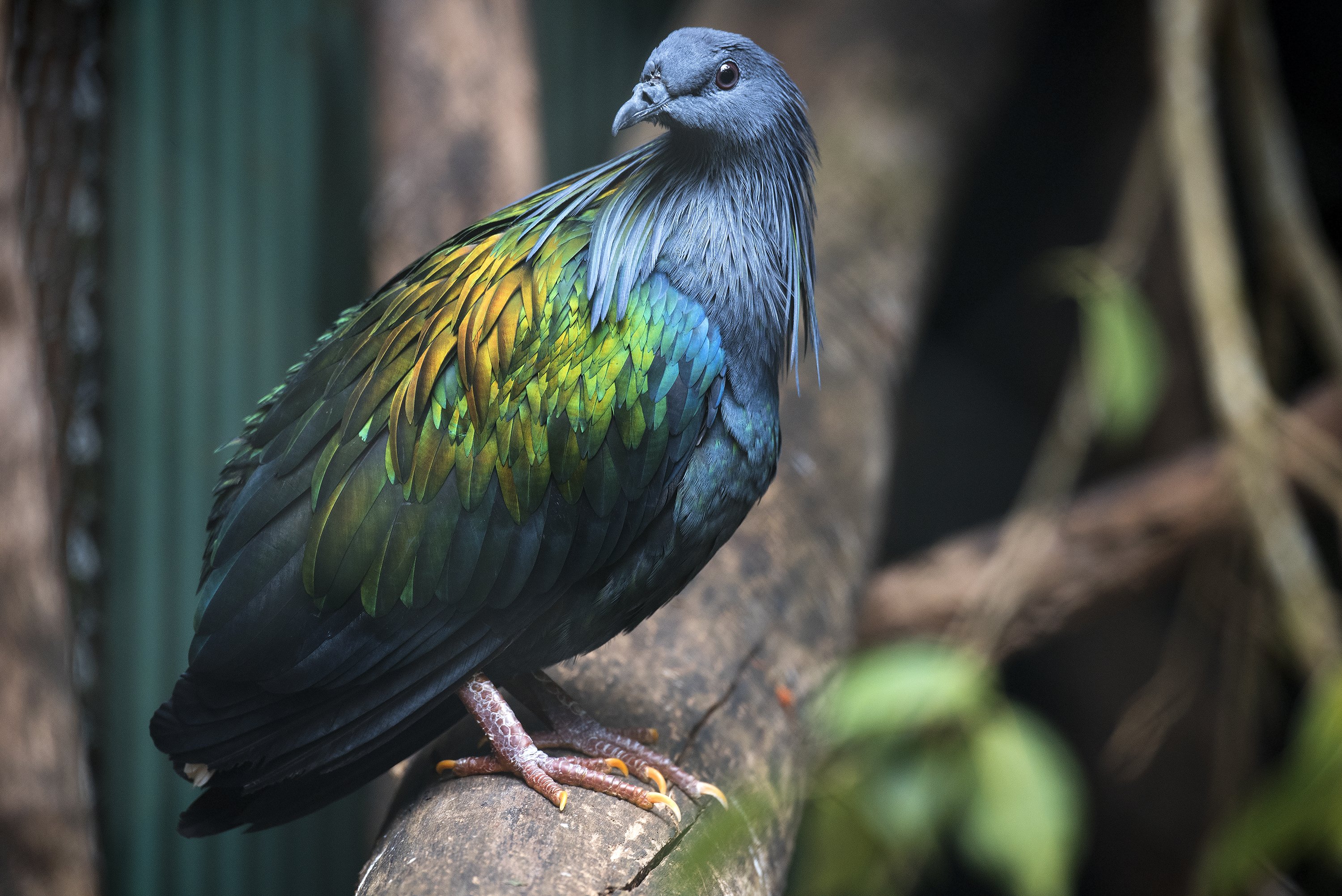
A Nicobar pigeon perched on top of a tree branch. | Source: Shutterstock
Native to the Nicobar Islands, Nicobar birds have long, magnificent plumes, and their sparkling feathers come in a wide range of rainbow shades. You might not notice their magical iridescence in the shade, but the colors glimmer and shine in the sunlight, offering an unbelievable and mesmerizing sight.
The splash of rich colors, including dark gray, green, blue, bronze, and silvery tints of orange and yellow, are visible throughout the length of the feathers covering their bodies. The pigeons comprise long neck feathers, also known as hackles, which enhance their elegance and give them an embellished look.
To steer clear from predators, Nicobar birds prefer nesting on smaller and comparatively less crowded islands. When searching for food, they fly in large flocks to the mainland regions and bigger islands, drawing strength from their growing numbers.
Courtship, Mating, and Incubation Duties
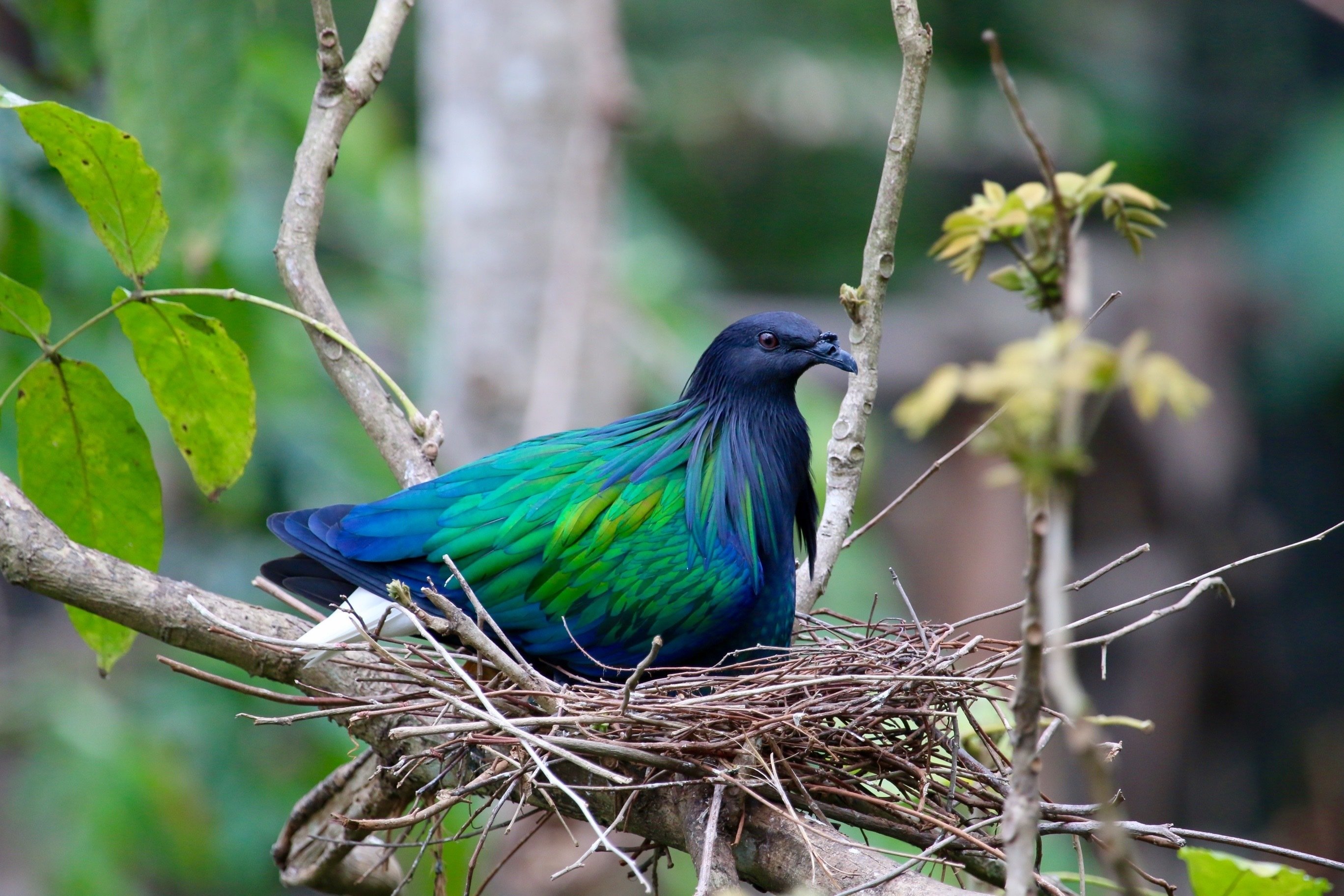
A Nicobar pigeon sitting in its nest | Source: Shutterstock
When the breeding season starts, the male Nicobar pigeon graciously courts its female counterpart, grabbing attention with loud, cooing sounds and other adorable actions, such as bowing. Mating may go on for extended periods, with the male bird tasked with choosing the nest sites.
Together, the birds construct their home in the trees, with the male bringing sticks and other required items and the female organizing them to make a nest. Typically, only one egg is laid at a time, which is bluish-white in color and takes nearly two weeks to hatch.
The male and female pigeons take turns during the incubation period, with babies staying in the nest for about four weeks after hatching. The babies or chicks feed on crop milk secreted from the parent's neck pouch.
Close Ties with the Dodo Bird
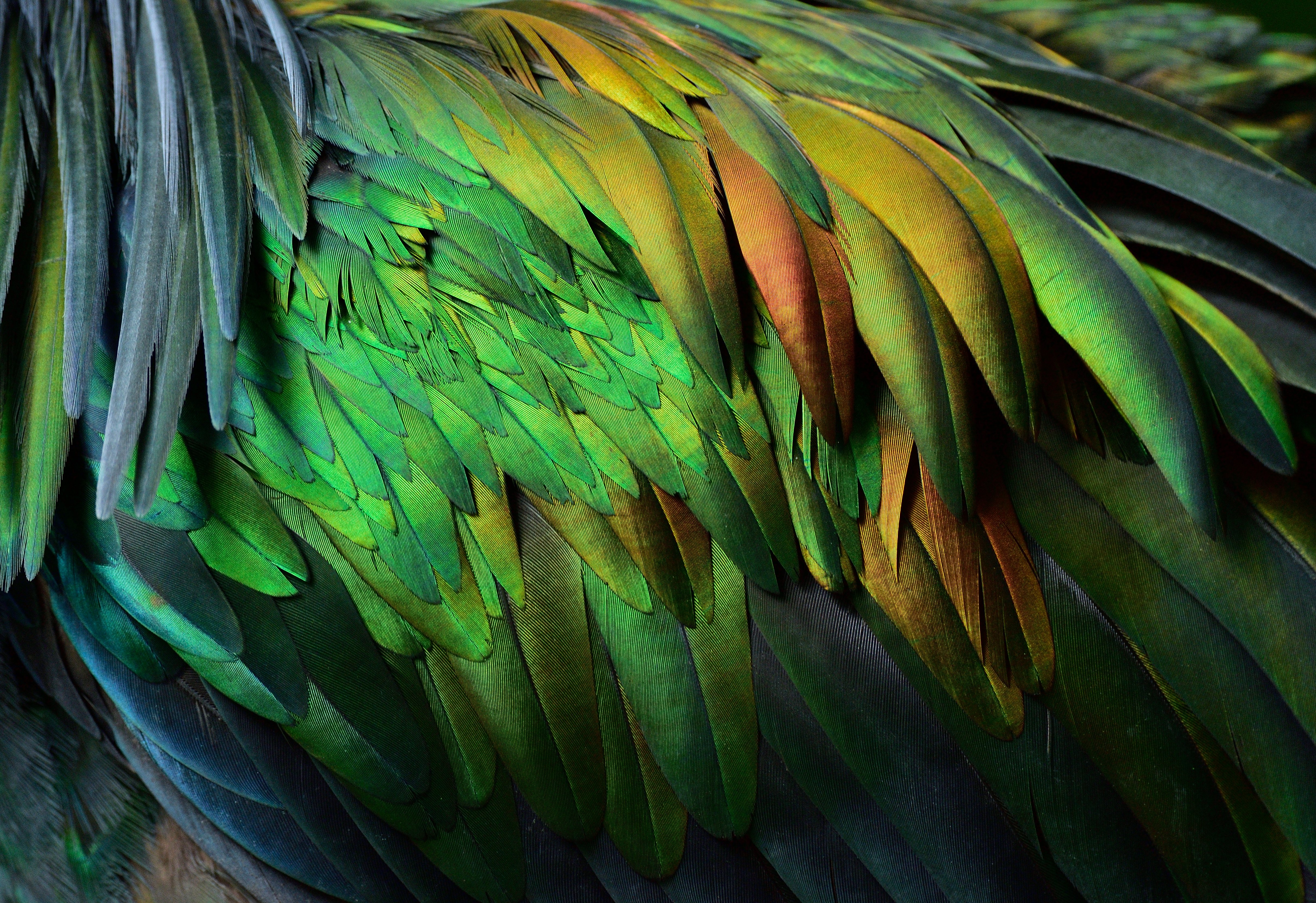
The rainbow-colored, lustrous feathers of a Nicobar pigeon. | Source: Shutterstock
Pigeons are considered the first birds to be domesticated, and according to DNA testing, the Nicobar pigeon has close ties with the famous Dodo, now extinct. Interestingly enough, the Nicobar pigeon is its nearest living relative.
Like dinosaurs, the three-foot-tall Dodo bird became extinct long ago, but its presence can still be felt today. While the Nicobar and Dodo are genetically related, they share no visible similarities in their physical appearance. The flightless Dodo bird had a bulbous beak, stout physique, and dull gray plumage.
On the contrary, the Nicobar bird has a petite frame, pointed beak, and extravagant plumage. It is deemed one of the most exquisite bird species because of its rainbow colors and compact upper body. Moreover, its glossy feathers, shining hackles, and defining white tail magnify its charm.
It is believed that the dazzling Nicobar pigeon developed its rich color palette due to the lack of natural predators in the smaller wooded regions. Because of its gorgeous features, it stands out from other breeds of pigeons and birds, especially doves, and feels no need to camouflage.
Both the Dodo and Nicobar are considered island birds—another trait that signifies their close genetic relationship. Sadly, the Nicobar is also on the brink of extinction, like its famous relative, and is threatened by the same factors that once contributed to the Dodo's disappearance from the earth.
The Dodo Bird's Journey from Discovery to Extinction
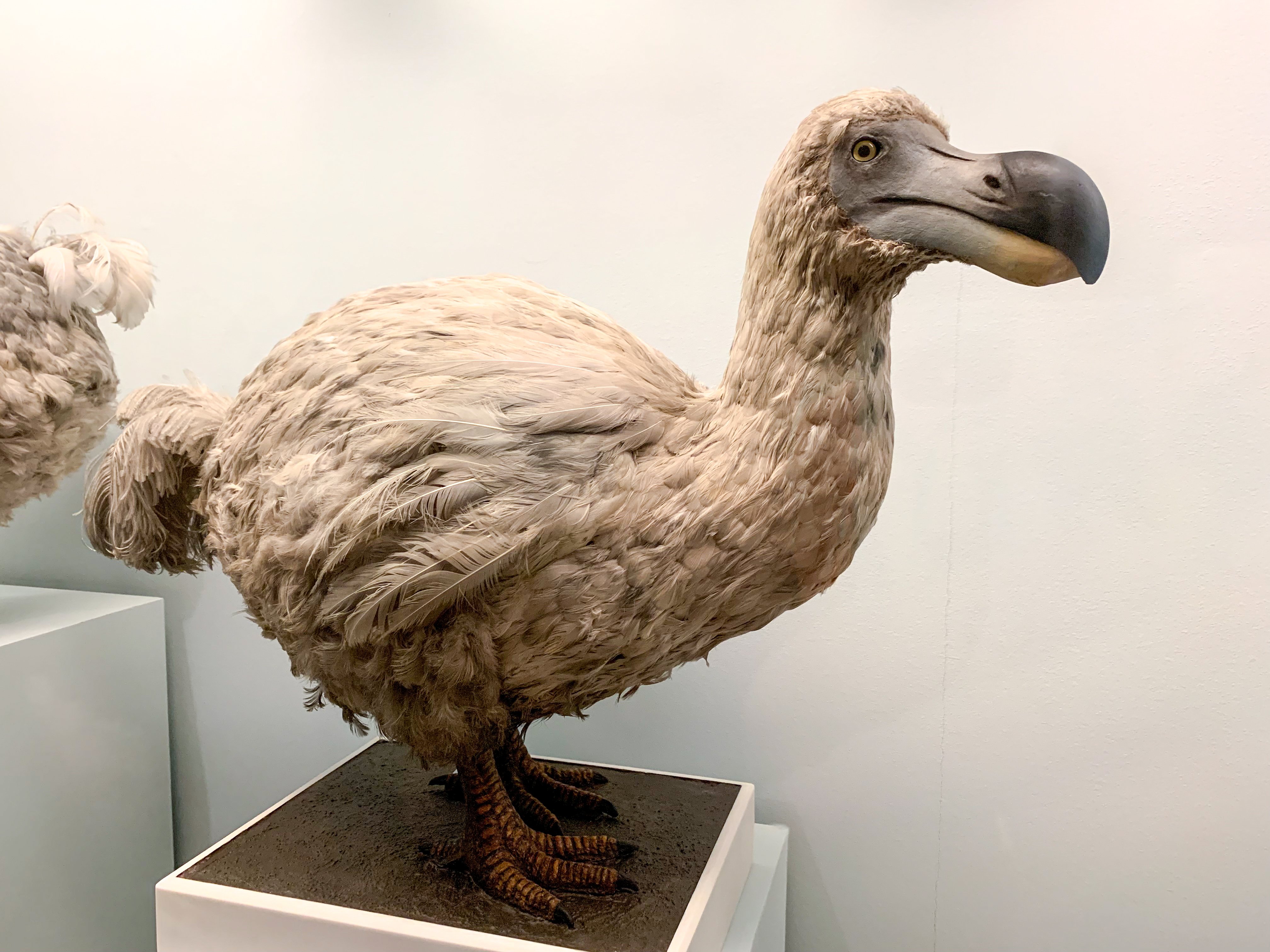
A stuffed Dodo bird placed in a museum | Source: Shutterstock
It may sound appalling and deeply upsetting, but humans played a pivotal role in the Dodo bird's extinction. The Dodo was an enormous flightless bird that dotted the island of Mauritius in the Indian Ocean; in fact, it weighed nearly 23 kilograms and was considered larger than a turkey.
Despite having tiny wings, gray-blue feathers, and a big head and beak, it could not fly. Dodos were terrestrial birds, but their hollow bone structure resembled birds that could fly. They preferred nesting on the ground, and like Nicobar pigeons, they laid one egg at a time.
Around 1507, a few Portuguese sailors were said to have discovered the Dodos; less than 200 years later, the species had gone extinct. While they had no natural predators initially, everything changed when human settlers arrived on the island and threatened their survival.
Many sailors who visited the region preferred to eat Dodos as a handy source of fresh meat. They also brought along other animals, such as monkeys, pigs, cats, and dogs, who put the Dodo bird's existence at stake by eating their eggs and competing with them for food.
Consequently, Dodos found themselves in mayhem and were soon on the losing end; not only were they over-harvested, but the other animals also outnumbered them. After the last Dodo was killed in 1681, the whole species was wiped from the earth, and nobody heard even an echo afterward.
Interesting Facts about the Dodo Bird
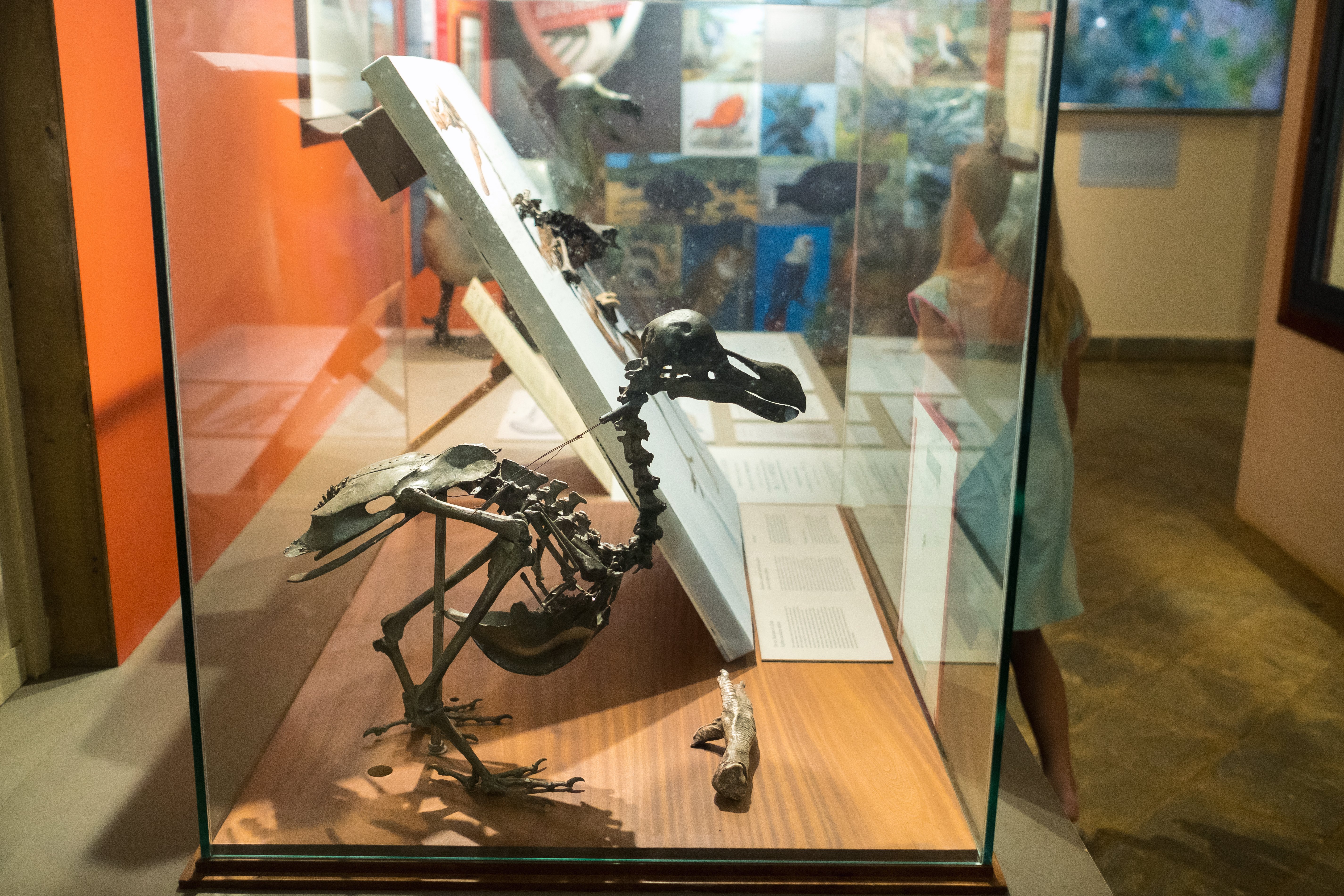
The Dodo bird's remains placed in a museum in Mauritius | Source: Shutterstock
The Dodo birds have become a story of the bygone era, but that wasn't always the case. There was a time when humans were familiar with their existence, and they walked the earth just like any other species.
Once a lost flock of pigeons who landed on the island of Mauritius, the birds thrived and evolved into Dodos over a span of hundreds of thousands of years. Many believe that the Dutch settlers first saw the flightless birds when they came to Mauritius in 1598.
The hapless birds lived a calm and carefree life, but everything went awry when humans decimated their population, followed by other predatory animals. Over time, they became flightless, a recurrent factor in bird evolution that left them disadvantaged when seeking shelter and protection.
Thinking that they had no enemies out to get them, Dodos became comfortable with laying a single egg, which hampered their survival in the longer run.
In addition to Nicobar pigeons across the Southern Pacific region, the Dodos were also linked to Rodrigues solitaire, found on the Indian Island ocean of Rodrigues. However, the solitaires ended up facing the same fate as their popular cousins and became extinct over time.
Not long after its discovery, the Dodo became known as the "Wallowbird" by the Dutch, and a few Portuguese sailors even called it a penguin because of its small wings.
There are variations as to how the term "Dodo" was coined, with some thinking it was derived from the Dutch word "Dodoor," which meant sluggard, or the Portuguese word "Doudo," translating to maniac.
The long-gone Dodos were also mentioned in Lewis Carroll's classic, "Alice's Adventures in Wonderland." Dodos staged a "Caucus Race" in the story, and many believe the bird represented Caroll himself.
Given the few preserved remnants of the Dodo bird, scientists think it might be possible to use DNA fragments for a shot at de-extinction or use Nicobar pigeons to try surrogate parenting.
The Nicobar Pigeon's Dazzling Effect on the Online Community
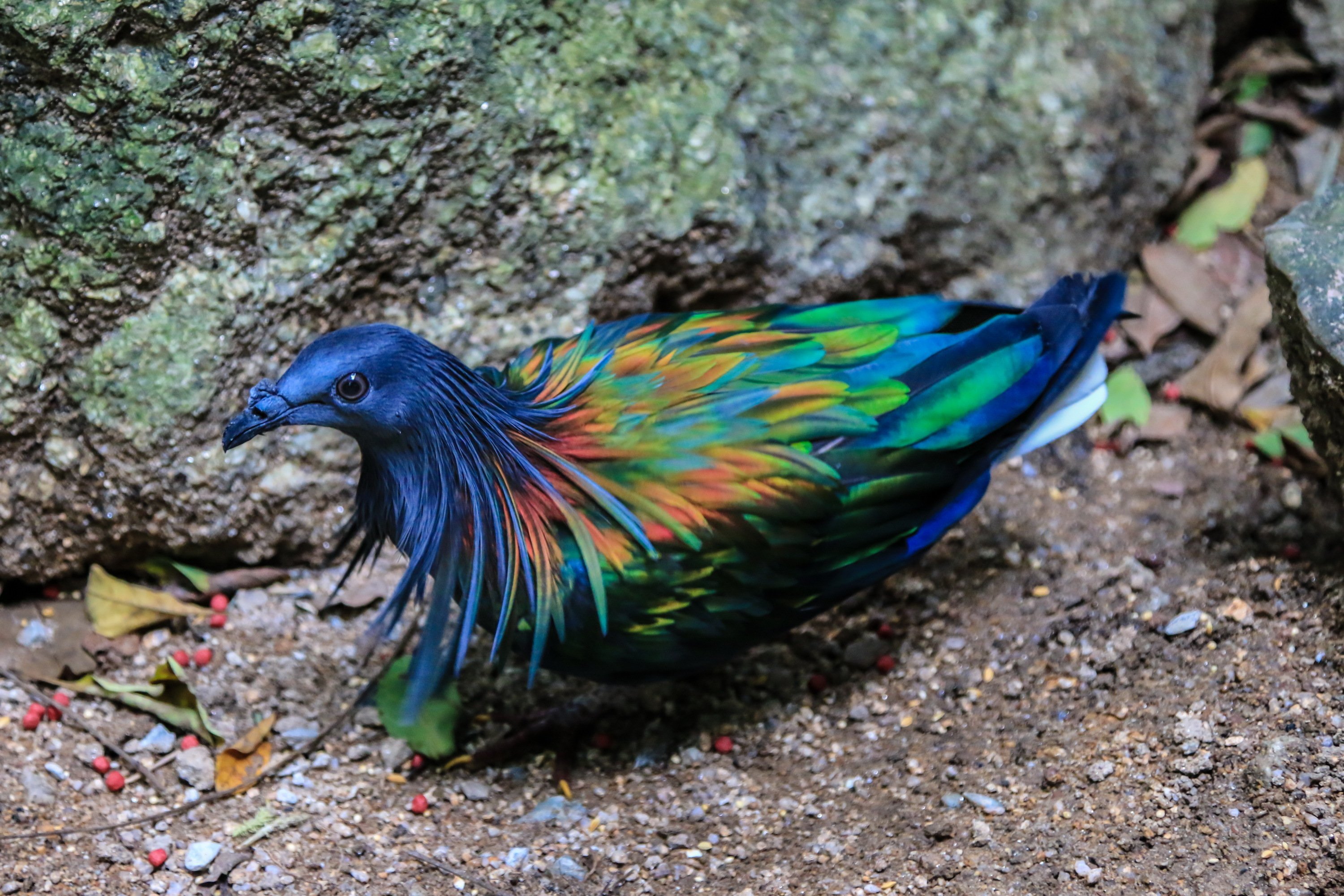
A Nicobar pigeon | Source: Shutterstock
The Nicobar birds have a dazzling effect on people and a charm that doesn't wear off quickly. A Facebook post on the Southeast Asian pigeons gained traction, garnering an overwhelming response from people far and wide. Here are a few comments that they wrote:
"Father God you sure have created many beautiful and unusual birds (sic)."
— (@patricia.jeffs2) September 13, 2022
"What a beautiful Bird. Just look at GOD Creation. Just amazing (sic)."
— (@tikva.morrissey.18) September 13, 2022
"Awesome. Nobody else but God could create such a beauty."
— (@florence.kande.583) September 13, 2022
"He is gorgeous. Looks like God painted him by sweeping a rainbow over his body. I love it."
— (@melissa.dunston.125) September 13, 2022
"God is so artistic with his creatures."
— (@ellen.keliinoi) September 13, 2022
"Omg it's absolutely stunning. I love all the colours and the birds cute face. Beautiful bird."
— (@linda.prosser.583) September 13, 2022
"Such a striking bird, all the colours of a rainbow! Nature reveals new treasures everyday!"
— (@nadine.heaphy.5) September 13, 2022
"Wow!! Such a totally gorgeous bird!! So stunning!! Such vibrant colors (sic)!!"
— (@coleen.ayala) September 13, 2022
"ABSOLUTELY BEAUTIFULL!! WHAT A MIGHTY we GOD SERVE (sic)!!"
— (@Petro-Jones) September 13, 2022
"So beautiful bird, so wonderful, praise God! Thanks Lord for your very beautiful creation (sic)!"
— (@Ninette-Tabile) September 16, 2022
While we cannot go back in time and observe the Dodo birds, we're still fortunate to be able to see the Nicobar pigeons and admire their glorious beauty. Although these lovely birds are near threatened, preventive measures can help turn things around.
Nicobar pigeons are one of the finest examples of God's artistic skills and should be protected and guarded at all costs. If we wish to see them thriving in the times to come, we must ensure we don't repeat the same mistakes we made with their famous cousins—the Dodo birds.
Although humans have a natural advantage over many animal and bird species, it's best to develop a conducive environment where everyone can feel safe, happy, and calm. By fostering seeds of friendship and trust, we can create a world where no species feels threatened by the other.
We hope wildlife and relevant authorities can take the necessary steps to prevent the stunning Nicobar pigeons from suffering the same consequences as Dodos and several other extinct species.
Have you ever sighted a dazzling Nicobar bird or planned on doing so in the future? If you enjoyed reading this piece, please share your feedback on Facebook and stay tuned for more exciting content.
Click here to find out how a Dallas zoo welcomed a much-anticipated hippo after 2.5 hours of labor.
